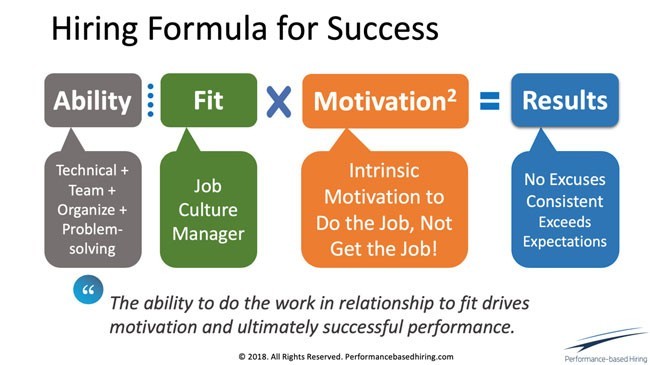Assessing Motivation Can Make or Break Your Next Hire — Here's How to Do It
In my 40+ years of recruiting, I’ve learned that recruiters often make a critical mistake in assessing a candidate for a position. Simply put, they think a candidate’s motivation to get the job (such as being prepared and on-time for the interview) is the same as their drive to do the job once they’re hired. It isn’t. Since motivation is largely driven by what I call Fit Factors, measuring fit should be the focus of most interviews. This represents the difference between a good and a bad hiring decision.
After more than 500 placements, I’ve learned what it takes to make a good hire with my Hiring Formula for Success, shown in the graphic below:
What may come as a surprise is that the ability to do the work is the easiest of the factors to assess. Motivation, it turns out, is the hardest, but it’s also the most important because without it even the most competent people will underperform. The reason it’s so difficult to assess is that it’s a variable dependent on my three Fit Factors: fit with the job, fit with the environment and company culture, and fit with the hiring manager’s personality and leadership style.
But before you can assess these factors, you need to find out if your candidate has the key skills to be successful in the role.
Assess competency by defining your key performance objectives (KPOs) and asking candidates if they have experiences to match them
Assessing competency has little to do with box-checking skills or asking generic questions to determine technical brilliance. Instead, it relates to the actual work a person needs to do to be successful on the job. To figure this part out, I ask hiring managers to describe how a required critical skill or competency is actually used on the job. Here are a few examples that clearly show the difference between a skill and how it’s used on-the-job:
- Need a Big-4 CPA with 5-10 years of international reporting: Lead the integration of the international consolidations reporting package on an F100 SAP-platform by year-end.
- Looking for an AI SW developer with 3+ years in NLP, expert systems, and conversational interface: Build a state-of-the art chatbot to convert incoming leads into scheduled meetings.
- A great job for an experienced (minimum 3-5 years) equipment sales rep with exceptional knowledge of IoT and SaaS based services: Optimize a new SMB territory representing a new advanced automated Supply Chain and Logistics platform.
Every job can be described with 5-6 KPOs like these that describe the task, the action required, and some measure of success. As long as a person can do the work, they should have the correct mix of skills. This is rarely what’s written on the job description, but proving the person can do the work involves asking the candidate to describe examples of major accomplishments for each of the KPOs. This is called the Most Significant Accomplishment (MSA) questioning pattern.
While this is a good start, it’s not enough to accurately predict on-the-job success. This is where the three Fit Factors come in.
Learn what motivates candidates by assessing these “Fit Factors”
Without a complete assessment of the three Fit Factors described below and how they affect motivation and performance, it’s unlikely your candidate will meet the expectations defined in the KPOs. Here’s how to figure this out as part of the MSA questions:
1. Job fit relates to work the person finds intrinsically motivating. If the person is not naturally motivated to do the work required, they will need too much direction and will likely underperform. When asking about accomplishments, get lots of examples of when the candidate took the initiative or went the extra mile. Patterns will soon emerge revealing the work the person finds intrinsically motivating.
2. Managerial fit relates to how the person needs or wants to be managed, and how well this matches with how the hiring manager for the position manages and develops people. Be sure to ask about this during the interview. Raise the caution flag if the new hiring manager’s style is at odds with how the person wants to be managed.
3. Environmental fit relates to the culture and pace of the organization. If the person can’t deal with the company’s pace, politics, and available resources, they will likely underperform. A great proxy for cultural fit is how major decisions are made and if the person finds this stifling, appropriate, or exhilarating. Have the candidate describe a major decision they made to fully understand this critical fit factor.
Final thoughts
Although motivation is at the core of exceptional performance, candidates often don’t even get a chance to show it because they’ve been screened out based on some arbitrary list of skills and academic requirements — often which have little to do with actual ability or the motivation to do the work. To make matters worse, when deciding whom to hire, recruiters often fall into the trap of letting the candidate’s motivation to get the job and the first impression dominate the yes/no hiring decision. The solution to this conundrum is recognizing that the Fit Factors drive success and unless they’re assessed accurately, a successful hire is unlikely.
To receive blog posts like this one straight in your inbox, subscribe to the blog newsletter.
Topics: Recruiting tips
Related articles





